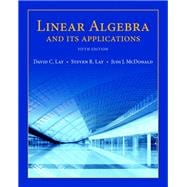About This Book
Linear Algebra and Its Applications, 5th Edition
Linear Algebra and Its Applications, 5th Edition, is a comprehensive textbook designed for undergraduate and graduate courses in linear algebra. This book is a go-to resource for students and educators alike, offering a detailed exploration of linear algebra principles and meeting scope and sequence requirements for typical introductory linear algebra courses.
Who Uses It?
Primarily, this book is used by students and instructors in introductory linear algebra courses at the college and university levels. It's also a valuable resource for anyone interested in understanding the basics of linear algebra, including professionals looking to refresh their knowledge or expand their understanding of mathematical principles.
History and Editions
The 5th edition of Linear Algebra and Its Applications has been updated to address user feedback, incorporating the latest research and discussions on linear algebra concepts. This edition includes detailed updates on clarity and accuracy, ensuring that students have a solid foundation in the material before moving on to more advanced topics. The book makes abstract concepts more accessible by introducing them early in a familiar, concrete setting and developing them gradually throughout the text.
Author and Other Works
David Lay, Steven Lay, and Judi McDonald are the authors of Linear Algebra and Its Applications. David Lay is known for his clear and concise writing style, which makes complex linear algebra concepts easier to understand. The authors have ensured that the text remains current and relevant by incorporating the latest research in the field.
Key Features
- Comprehensive Coverage: The book covers core concepts in linear algebra, including detailed explanations and examples.
- Gradual Development: The text introduces abstract concepts gradually, making them more accessible to students.
- Concrete Setting: The book starts with familiar, concrete settings (e.g., Rn) to help students understand complex concepts better.
- Instructor Resources: The book is complemented by instructor resources such as the Instructor’s Solutions Manual, which contains detailed solutions for all exercises, along with teaching notes for many sections.
Detailed Information
ISBNs and Formats
- Hardcover: ISBN-13: 9780321982384
- Publisher: Pearson
- Publication Date: March 16, 2025
- Number of Pages: 576 pages
- Language: English
Other Editions and Formats
- Related ISBNs:
- 9780134013473 (related ISBN for MyLab & Mastering products)
- 0134013476 (related ISBN for MyLab & Mastering products)
Rental Options:
- Rental 90 Days Ready to Ship: $26.87 + $3.95 shipping = $30.82 total
- Used Ships 2-3 Days: $46.01 + $3.99 shipping = $50.00 total
- New Ships 2-3 Days: $117.38 + $4.49 shipping = $121.87 total
Publication Details
- Publisher: Pearson
- Publication Date: March 16, 2025
- Item Weight: Not specified
- Dimensions: Not specified
Instructor Resources:
- Instructor’s Solutions Manual: Available electronically for download in the Instructor Resource Center (www.pearsonhighered.com/lay) and MyMathLab.
- PowerPoint Slides: Available for download (ISBN 0-321-98264-9).
This detailed information section provides a quick reference for all the available formats and sources for Linear Algebra and Its Applications, 5th Edition, making it easier to find and access the book in the preferred format.









